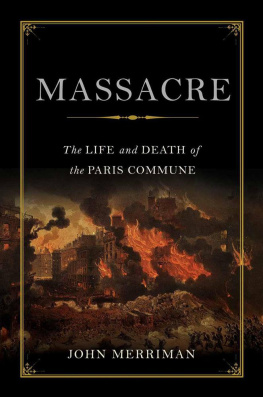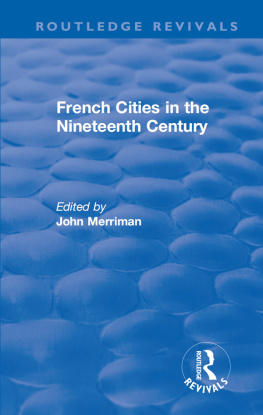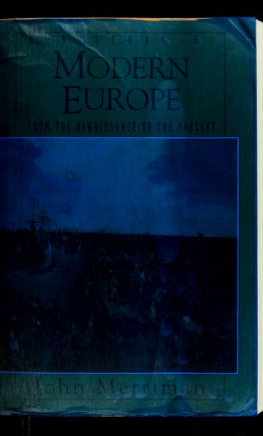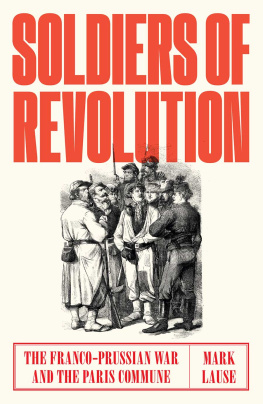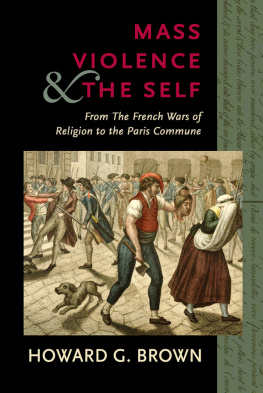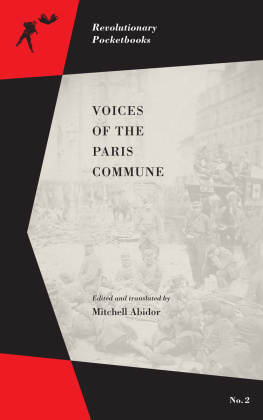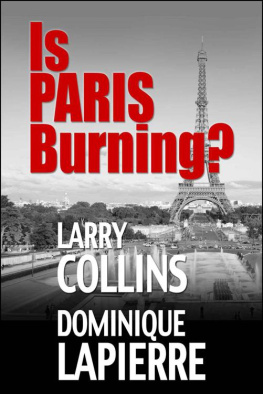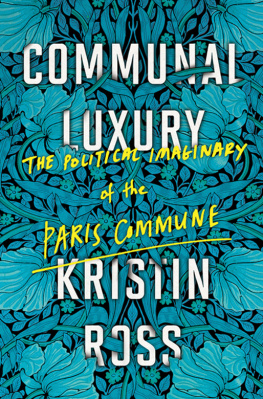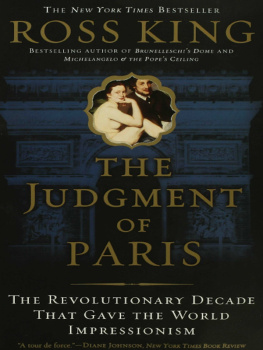Advance Praise for Massacre
Massacre is an absorbing and very moving read. John Merriman has found exactly the right unemotional tone and mastery of detailincluding many new stories heretofore unpublishedto produce the best popular history of the Commune, in English or French, in a generation.
Steven Englund, author of Napoleon: A Political Life
Dream of emancipation, nightmare of repressionthe Paris Commune was a focal point of the political imagination of nineteenth-century Europe. John Merrimans new book brings vividly to life the hopes and fears, the passions and hatreds, and the social and political struggles that inspired a famous revolutionary regime and led to its violent destruction.
Jonathan Sperber, author of Karl Marx: A Nineteenth-Century Life
Copyright 2014 by John Merriman
Published by Basic Books, A Member of the Perseus Books Group
All rights reserved. Printed in the United States of America. No part of this book may be reproduced in any manner whatsoever without written permission except in the case of brief quotations embodied in critical articles and reviews. For information, address Basic Books, 250 West 57th Street, New York, NY 10107.
Books published by Basic Books are available at special discounts for bulk purchases in the United States by corporations, institutions, and other organizations. For more information, please contact the Special Markets Department at the Perseus Books Group, 2300 Chestnut Street, Suite 200, Philadelphia, PA 19103, or call (800) 8104145, ext. 5000, or e-mail .
Text design by Cynthia Young
Library of Congress Cataloging-in-Publication Data
Merriman, John M.
Massacre : the life and death of the Paris Commune / John Merriman.
pages cm
Includes bibliographical references and index.
ISBN 978-0-465-05682-8 (ebook)
1. Paris (France)HistoryCommune, 1871. 2. Social conflictFranceParisHistory19th century. 3. ViolenceFranceParisHistory19th century. 4. MassacresFranceParisHistory19th century. 5. Paris (France)Politics and government19th century. 6. Paris (France)Social conditions19th century. 7. FrancePolitics and government18701940. I. Title.
DC317.M365 2014
944.0812dc23
2014023988
For Don Lamm
ON MARCH 18, 1871, Parisians living on Montmartre awoke to the sounds of French troops attempting to seize the cannons of the National Guard. The troops acted under the orders of Adolphe Thiers, the conservative head of a provisional government recently ensconced in Versailles, once the residence of the Bourbon monarchs of the Ancien Rgime. Thiers, fearing the mobilization of angry and radicalized Parisians, wanted to disarm their city and its National Guard, whose ranks comprised, for the most part, workers desirous of a strong republic and angered by the capitulation of the provisional government in the disastrous war against Prussia that had begun the previous July and brought about the fall of the Second Empire.
Despite the efforts of the French army, the men and women of Montmartre, Belleville, and Buttes-Chaumont courageously prevented the troops from taking the cannons. Seeing about 4,000 soldiers arrive on Montmartre, then halt to await the arrival of the horses necessary to haul the weapons down the hill, women sounded the alarm. Working-class residents of the butte overlooking the French capital prevented the heavily armed troops from hitching the cannons to horses and, in keeping with the tradition of revolutionary defiance, began to build barricades. Soldiers started to fraternize with the people of Montmartre. The 6,000 troops sent to Belleville, La Villette, and Mnilmontant fared no better. Parisians would keep their cannons.
Thwarted, Thiers withdrew his forces from Paris to Versailles, where he planned to regroup and eventually retake the city. Thousands of wealthy Parisians joined him there. In Paris, left-wing militants proclaimed a Commune of progressive self-government that brought freedom to Parisians, many of whom believed themselves masters of their own lives for the first time. Working-class families from proletarian neighborhoods proudly strolled into the beaux quartiers of the capital, imagining a more just society and prepared to take steps to make it a reality. Their progressive Commune would last a mere ten weeks before Thierss troops annihilated it during the last bloody week of May.
The birth and destruction of the Paris Commune, one of the most tragic, defining events of the nineteenth century, still resonate today. In the streets of Paris, Thierss army gunned down thousands of ordinary men, women, and, occasionally, children. Soldiers killed many for their defense of the Commune; others died because their workers attire, remnants of a Parisian National Guard uniform, or manner of speaking marked them for death. The massacres by French troops of their countrymen anticipated the demons of the century to follow. You could be gunned down simply because of who you were, because you had the nerve to demand freedom. This may have been the ultimate significance of Bloody Week, May 21 to 28, 1871, the biggest massacre in nineteenth-century Europe.
PARIS WAS A SURGING CITY of great social contrasts and contradictions during Napoleon IIIs Second Empire (18521870). On one hand, the capital led a rapidly growing French economy. Artisans in small workshops dominated industry, producing the articles de Paris high-quality gloves, and other luxury goods that came to epitomize French manufacturing. Imperial financial institutions helped boost industrial production in and around Paris, bringing unparalleled prosperity to people of means, who attended lavish social events and theatrical performances, traversing the city and the Bois-de-Boulogne in carriages while ordinary people walked to work. Powerful trains, their engines spewing steam, carried wealthy passengers from the burgeoning capital to Deauville and other increasingly elegant towns on the Norman coast.
The economic boom and the incredible wealth it brought to Paris diverted attention from widespread poverty and divisions in the city. Napoleon III and Baron Georges Haussmann plowed spacious boulevards through the tangle of medieval Paris. Fancy restaurants and cafs welcomed those who could afford to frequent them. In the dilapidated and overcrowded districts of eastern and northern Paris, working people living in miserable tiny apartments or rooming houses struggled to get by. For them, the hard times never seemed to end.
By the late 1860s, Napoleon III faced mounting political opposition, so much so that many Parisians anticipated a disastrous end to his reign. France already had a lengthy history of class strife. Three revolutions had chased monarchs from the French throne over the previous sixty years. So far, none had brought to France the stability found across the English Channel in Great Britain.
Napoleon III, however, was confident that he, unlike his immediate predecessors, would hold onto power. Born in 1808, Louis Napoleon Bonaparte, the son of Napoleons brother, had grown up in a Swiss chateau amid artifacts of his uncles rule. Certain of his destiny to build on his famous familys dynastic heritage, which he identified with the fate of France, he added to his ambition a shrewd political opportunism combined with notoriously bad judgment. The July Monarchy of King Louis-Philippe of the Orlans family (a junior wing of the Bourbons, the French royal family) maintained its policy of forcing the family of Napoleon Bonaparte to remain in exile. Louis Napoleon had attempted to invade France with a handful of followers in 1836, when he marched into a Strasbourg garrison and was arrested, and then again four years later, when he landed on the coast near Boulogne-sur-Mer, with the same embarrassing result. Imprisoned in 1840 in northern France, he escaped in 1846 dressed as a worker. These fiascos earned him a reputation as something of a buffoon who surrounded himself with sleazy, inept cronies. Short and increasingly corpulent, he resembled his uncleto whom his enemies compared him, calling him the [Napoleonic] hat without the head and poking fun at his fish eyes.
Next page
